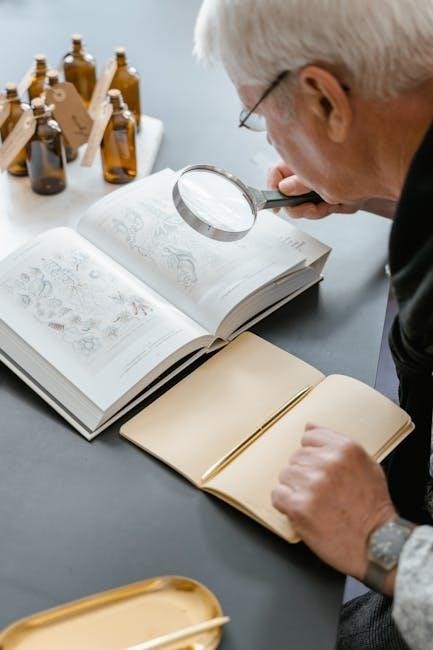Through the Looking-Glass: A Comprehensive Guide to the PDF Version
Dive into Lewis Carroll’s whimsical world with our comprehensive guide to “Through the Looking-Glass” in PDF format․ Discover free download sources like Project Gutenberg and Standard Ebooks, offering convenient access to this literary classic․ Explore the enchanting realm alongside Alice through readily available PDF versions․
Embark on a journey through the looking glass, a sequel to “Alice’s Adventures in Wonderland,” penned by Lewis Carroll in 1871․ This enchanting novel continues the tale of Alice, a young English girl, as she ventures into a fantastical realm mirroring her own․ Within this whimsical world, Alice traverses a peculiar landscape populated by chess pieces, talking flowers, and a myriad of other unusual characters․
“Through the Looking-Glass” invites readers to explore a world where logic is inverted and the imagination reigns supreme․ Join Alice as she navigates this nonsensical realm, encountering memorable characters like the Red Queen, Tweedledee and Tweedledum, and the Jabberwock․ Each encounter presents Alice with unique challenges and opportunities for growth, testing her wit and resilience in a world that defies expectations․
Prepare to be captivated by Carroll’s ingenious wordplay, whimsical storytelling, and profound exploration of themes such as identity, logic, and the power of imagination․ “Through the Looking-Glass” remains a timeless classic, enjoyed by readers of all ages for its enduring charm and thought-provoking narrative․
Historical Context and Publication of the Book
“Through the Looking-Glass,” a sequel to “Alice’s Adventures in Wonderland,” emerged from the creative mind of Lewis Carroll during the Victorian era․ Published in 1871, this novel reflected the societal norms and intellectual curiosities of the time, captivating readers with its whimsical narrative and thought-provoking themes․ Carroll, a mathematician and logician, infused the story with puzzles, wordplay, and reflections on language and reality;
The mid-19th century witnessed a burgeoning interest in children’s literature, and Carroll’s Alice books played a significant role in shaping this genre․ Unlike didactic tales prevalent at the time, “Through the Looking-Glass” embraced nonsense and imagination, offering readers an escape into a fantastical world․ The book’s publication coincided with advancements in printing technology, allowing for widespread distribution and accessibility․
“Through the Looking-Glass” quickly gained popularity, captivating audiences with its clever storytelling and memorable characters․ Its enduring appeal lies in its ability to engage readers of all ages, inviting them to question conventional thinking and embrace the power of imagination․ The historical context surrounding its publication provides valuable insights into the book’s themes and its lasting impact on literature․
Availability of “Through the Looking-Glass” in PDF Format
“Through the Looking-Glass,” a timeless classic by Lewis Carroll, enjoys widespread availability in PDF format, making it easily accessible to readers worldwide․ Thanks to digital libraries and online platforms, this enchanting tale can be enjoyed on various devices, including computers, tablets, and smartphones․ The PDF format preserves the book’s original layout and illustrations, offering an authentic reading experience․
Numerous websites and online repositories provide free PDF downloads of “Through the Looking-Glass,” catering to diverse reading preferences․ Project Gutenberg, a renowned digital library, offers a high-quality PDF version of the book, ensuring accessibility for all․ Standard Ebooks also provides a meticulously formatted PDF edition, enhancing readability and visual appeal․
The availability of “Through the Looking-Glass” in PDF format democratizes access to literature, allowing readers to engage with this beloved story regardless of their location or financial constraints․ Whether for academic study, personal enjoyment, or sharing with others, the PDF version offers a convenient and cost-effective way to experience the magic of Alice’s adventures in the Looking-Glass world․
Where to Download Free PDF Versions
Finding free PDF versions of “Through the Looking-Glass” is remarkably easy, thanks to numerous online resources dedicated to preserving and sharing classic literature․ Project Gutenberg stands out as a premier source, offering a meticulously digitized version of the book that can be downloaded without any cost or registration․ Their PDF is a faithful representation of the original text․

Another excellent option is Standard Ebooks, which provides a beautifully formatted and proofread PDF edition of “Through the Looking-Glass․” Standard Ebooks focuses on creating high-quality, accessible ebooks, ensuring an enjoyable reading experience․ LibriVox also offers audio recordings of the book, often accompanied by a PDF version of the text for those who prefer to read along․
Before downloading, it’s wise to ensure the source is reputable to avoid malware or low-quality scans․ Look for established organizations like those mentioned above․ With a few clicks, you can access this literary treasure and embark on Alice’s adventures in the Looking-Glass world, all without spending a penny․
Project Gutenberg and “Through the Looking-Glass”
Project Gutenberg is a cornerstone of free access to literature, and “Through the Looking-Glass” is proudly featured in its extensive online library․ This digital haven provides a readily available PDF version of Lewis Carroll’s sequel to “Alice’s Adventures in Wonderland,” allowing readers worldwide to delve into its imaginative depths without cost․
The Project Gutenberg edition of “Through the Looking-Glass” offers a faithful reproduction of the original text․ Volunteers meticulously proofread and digitize each book to ensure accuracy․ This commitment to quality makes Project Gutenberg a reliable source for classic literature․ The PDF format is convenient for reading on various devices, from computers to tablets and e-readers․
Downloading “Through the Looking-Glass” from Project Gutenberg is simple․ Navigate to their website, search for the title, and choose the PDF option․ The file is yours to keep, share, and enjoy․ Project Gutenberg’s dedication to preserving literary works makes it an invaluable resource for readers and researchers alike․
LibriVox Audio and PDF Downloads
LibriVox offers a unique way to experience “Through the Looking-Glass” by combining audio recordings with readily accessible PDF downloads․ Volunteers worldwide contribute their voices to create free audiobooks of classic works, making literature accessible to a wider audience․ Alongside the audio version, LibriVox typically provides a PDF of the book, allowing listeners to follow along or read independently․
This combination is particularly beneficial for those who enjoy immersive reading experiences or have visual impairments․ The PDF serves as a visual aid, while the audiobook brings the story to life through expressive narration․ LibriVox recordings are available in various formats, ensuring compatibility with different devices․ The PDF downloads are usually sourced from Project Gutenberg, guaranteeing a faithful reproduction of the original text․
To access “Through the Looking-Glass” on LibriVox, simply visit their website, search for the title, and choose the audiobook version․ The PDF download link will typically be available on the same page, providing a seamless way to enjoy the story in both audio and visual formats․
Standard Ebooks Edition and PDF Availability
Standard Ebooks provides meticulously formatted and freely accessible editions of classic literature, including Lewis Carroll’s “Through the Looking-Glass․” Their goal is to create high-quality ebooks that are both aesthetically pleasing and technically sound․ The Standard Ebooks edition of “Through the Looking-Glass” is available in various formats, including a PDF, ensuring compatibility across different devices and reading preferences․
What sets Standard Ebooks apart is their commitment to preserving the original text while enhancing the reading experience․ They carefully proofread each edition, correct typographical errors, and format the text for optimal readability․ The PDF version retains the original illustrations by John Tenniel, adding to the book’s charm․
Downloading the PDF from Standard Ebooks is straightforward․ Simply visit their website, navigate to the “Through the Looking-Glass” page, and select the PDF download option․ The resulting file is DRM-free, allowing you to read it on any device without restrictions․ This makes Standard Ebooks an excellent source for a high-quality, accessible PDF of Carroll’s beloved sequel․
The Original Illustrations by John Tenniel
Sir John Tenniel’s iconic illustrations are integral to the enduring appeal of “Through the Looking-Glass․” His artwork brings Lewis Carroll’s whimsical characters and fantastical settings to life, enhancing the reader’s imagination and understanding of the story․ Tenniel’s collaboration with Carroll resulted in a visual representation that perfectly complements the text, solidifying the book’s place in literary history․
Tenniel’s illustrations are characterized by their intricate detail, expressive character portrayals, and subtle humor․ From the Mad Hatter to the Cheshire Cat, each character is rendered with distinctive features and personality․ The illustrations not only depict key scenes but also add layers of meaning to the narrative, enriching the overall reading experience․
Many PDF versions of “Through the Looking-Glass” strive to preserve Tenniel’s original illustrations, ensuring that readers can appreciate the book as it was initially intended․ These illustrations are often carefully scanned and included within the PDF, allowing readers to immerse themselves fully in Carroll’s imaginative world․ The presence of Tenniel’s artwork elevates the PDF version from a simple text file to a visually engaging experience․
Character Analysis in “Through the Looking-Glass”
“Through the Looking-Glass” boasts a cast of memorable and eccentric characters, each serving a unique purpose in Alice’s journey․ Analyzing these characters provides valuable insights into the novel’s themes and Carroll’s commentary on Victorian society․ From the logical yet absurd White Knight to the enigmatic Humpty Dumpty, each encounter shapes Alice’s understanding of the Looking-Glass world․
The Red Queen, a representation of authoritarian rule, embodies the relentless demands and illogical rules of the chess-like world․ The Tweedledee and Tweedledum twins, with their nonsensical arguments and readiness for battle, represent the absurdity of conflict․ These characters, among others, contribute to the novel’s exploration of identity, logic, and the nature of reality․

Understanding the motivations and symbolism behind each character enhances the reading experience, especially when accessing “Through the Looking-Glass” in PDF format․ Detailed character analyses available online can complement the text, providing a deeper appreciation for Carroll’s literary artistry․ By examining the roles and interactions of these characters, readers can uncover the hidden layers of meaning within the story․
Themes Explored in the Novel
“Through the Looking-Glass” delves into a multitude of thought-provoking themes, offering readers a rich and complex narrative beyond its surface-level whimsy․ Identity is a central theme, as Alice grapples with questions of self-discovery and transformation in the face of the Looking-Glass world’s absurdities․ The novel also explores the nature of logic and language, challenging conventional understandings and highlighting the potential for misinterpretation․
The concept of time is another recurring motif, symbolized by the chess game and the characters’ preoccupation with moving forward․ Carroll uses the Looking-Glass world to satirize Victorian society, exposing its rigid rules and social hierarchies․ The theme of duality is also prevalent, represented by the mirrored landscape and the opposing characters Alice encounters․
These themes are readily accessible to readers exploring “Through the Looking-Glass” in PDF format․ Online resources and literary analyses can further illuminate the thematic depth of the novel․ By examining these themes, readers can gain a deeper appreciation for Carroll’s intellectual and artistic contributions, recognizing the enduring relevance of his work in contemporary society․ The exploration of these themes truly enriches the reading experience․
“Looking-Glass House”: Chapter 1 Synopsis
Chapter 1, titled “Looking-Glass House,” sets the stage for Alice’s fantastical journey․ It begins with Alice playing with her kittens, Dinah, the black kitten, and Snowdrop, the white kitten, in her home․ She playfully imagines what the world is like on the other side of the looking-glass, a large mirror above the fireplace․ Alice wonders if the fire in the looking-glass is actually hot, and where the smoke goes, and what it’s like in the looking-glass house․
Intrigued, Alice climbs onto the mantelpiece and reaches through the looking-glass, discovering that it has become soft like a mist․ She steps through into the Looking-Glass House, finding everything to be a mirrored version of her own home․ She explores the living room, finding that the chess pieces are alive and can move on their own․
She finds a book with reversed printing and realizes it can only be read using a mirror․ This sets the tone for the reversed logic and nonsensical events that will characterize her adventures․ The chapter ends with Alice contemplating the chess game and expressing her desire to join․ This chapter is pivotal in establishing the magical setting and Alice’s curious nature;
Comparing “Alice’s Adventures in Wonderland” and “Through the Looking-Glass”
While both “Alice’s Adventures in Wonderland” and “Through the Looking-Glass” feature Alice’s fantastical experiences, they differ significantly in structure and themes․ “Alice’s Adventures in Wonderland” is more episodic and dreamlike, with Alice encountering a series of bizarre characters and situations in a seemingly random order․ “Through the Looking-Glass,” on the other hand, has a more structured narrative, resembling a chess game․ Alice progresses through the Looking-Glass world square by square, encountering characters and challenges that correspond to chess pieces and moves․
“Wonderland” explores themes of identity, growing up, and the absurdity of adult logic, whereas “Looking-Glass” delves into concepts of reversed logic, language, and the nature of reality․ The characters in “Looking-Glass” are often reflections or inversions of those in “Wonderland,” adding a layer of complexity and self-referentiality․ The humor in “Wonderland” is more whimsical and nonsensical, while in “Looking-Glass,” it is often based on wordplay and logical paradoxes․ Both books showcase Carroll’s creative imagination and masterful use of language, but “Through the Looking-Glass” offers a more intricate and intellectually stimulating reading experience․

Copyright Information and Usage of PDF Versions

Many PDF versions of “Through the Looking-Glass” are available due to the expiration of its copyright․ Lewis Carroll’s works, including “Through the Looking-Glass,” are now in the public domain in many countries․ This means that the original text is free to use, distribute, and adapt without permission or fees․ However, specific editions or adaptations may have their own copyrights․ For example, a PDF containing new illustrations or annotations may be subject to copyright restrictions on those additional elements․
When using a PDF version of “Through the Looking-Glass,” it’s essential to check the source and any accompanying copyright notices․ Project Gutenberg and Standard Ebooks typically offer versions that are entirely free of copyright restrictions․ Be mindful of any terms of use or licensing agreements associated with the specific PDF you download․ While you can freely share and use the original text, creating derivative works or commercial products based on copyrighted illustrations or adaptations may require permission from the copyright holder․ Always respect intellectual property rights and ensure compliance with applicable laws when using PDF versions of “Through the Looking-Glass․”
